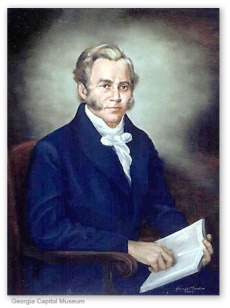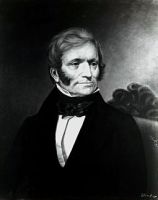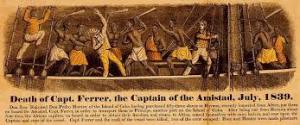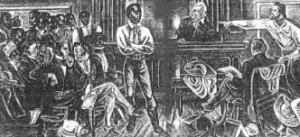
John Forsyth was born in 1780 and graduated from the College of New Jersey (later renamed Princeton University) in 1799. From 1813 to 1834, Forsyth served as a U.S. congressman, senator, and governor from Georgia. On July 1, 1834, Andrew Jackson appointed him as Secretary of State. He remained in that position during the Martin Van Buren administration.
Interestingly, Forsyth owned enslaved people. His views on the horrid institution was made clear by his opinion of free blacks. He stated, “We hold… that we have the right to exclude free People of Color, to eject them, and to limit their privileges, when we admit them to reside with us.”

His views on slavery most certainly influenced his political beliefs. In July 1839, a Spanish schooner named La Amistad was taken over by a group of slaves being shipped from Havana, Cuba. The slaves, originally from Sierra Leone in West Africa, killed the captain and the cook, and directed the navigator to take them back to Africa. Instead, the navigator took the ship north where they were capture by the U.S. Navy near Long, Island, New York, and Connecticut. Immediately, ownership of property was disputed by various parties, including the Spanish Government (back by the U.S. Government) and the men who claimed to have found the schooner first. Meanwhile, the Africans simply wanted their freedom.

The case made it all the way to the U.S. Supreme Court. Secretary of State Forsyth argued the case for the U.S. Government. He claimed that the only legal option was to return the vessel and the cargo to the Spanish, including the enslaved people. He legal opponent was former president, John Quincy Adams. In response to the call to free the slaves, Forsyth stated:
“These two points being disposed of–1st. That the Government of the United States is to consider these Negroes as the property of the individuals in whose behalf the Spanish minister has put up a claim; 2d. That he United States cannot proceed against them criminally; –the only remaining inquiry is, what is to be done with the vessel and cargo? the Negroes being part of the latter.”
Despite Forsyth’s claims, the Supreme Court ruled that since the Africans were in control of the ship, and didn’t wish to be slaves, that they had the right to return to Africa. The Court stated:
“Upon the whole, our opinion is, that the decree of the circuit court, affirming that of the district court, ought to be affirmed, except so far as it directs the negroes to be delivered to the president, to be transported to Africa, in pursuance of the act of the 3rd of March 1819; and as to this, it ought to be reversed: and that the said negroes be declared to be free, and be dismissed from the custody of the court, and go without delay.”

The court’s decision was a rallying cry for the abolitionist movement. However, Forsyth would never see the impact of the abolitionist movement which he so adamantly opposed. He passed away at the age of 60 in October 1841.
Duckett, Alvin Laroy, John Forsyth: Political Tactician (Athens: University of Georgia, 1962).
Pesci,David, Thunder of Freedom (New York: Marlowe and Company, 1997).